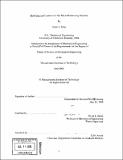Modeling and control of a hot micro-embossing machine
Author(s)
Shoji, Grant T. (Grant Tatsuo)
DownloadFull printable version (22.13Mb)
Other Contributors
Massachusetts Institute of Technology. Dept. of Mechanical Engineering.
Advisor
David E. Hardt.
Terms of use
Metadata
Show full item recordAbstract
As the market for polymer micro- and nano-devices expands there is an ever-present need for a manufacturing standard to mass produce these parts. A number of techniques for fabricating these devices are soft lithography, micro-injection molding, and micro-embossing. Micro-embossing shows great promise in terms of versatility in creating various structures, but its shortcoming is a relatively long cycle time. Therefore, it is imperative to find efficient ways of heating and cooling in addition to having good control of critical processing parameters. This thesis will address the modeling and control of a hot micro-embossing system which utilizes oil as the heating and cooling medium. There were three thermal requirements addressed for the system: steady state temperatures within 1 C, fast as possible heating and cooling cycles, and being robust to various embossing and de-embossing processing temperatures. A model of the major thermal components in the system was developed and correlated well with experimental data. It was confirmed with simulation and experimentation that a lower flow rate achieved faster heating and a higher flow rate produced faster cooling. In order to address the steady state temperature requirement a variable gain PI controller was implemented. (cont.) During heating the feedback signal was the platen temperature and during cooling the feedback signal was the mixing valve fluid outlet temperature. This variable gain PI controller in combination with the variable flow rates produced steady state temperatures for both platens from 55 to 120 °C within 1 C in 138 seconds. Cooling for both platens from 120 to 55 °C was achieved in 190 seconds. This controller worked for a variety of processing temperatures. A Labview interface was developed to automate this process for temperature step changes. Polymer microfluidic channels were successfully fabricated using this hot micro-embossing system with automated thermal control in a short cycle time.
Description
Thesis (S.M.)--Massachusetts Institute of Technology, Dept. of Mechanical Engineering, 2006. "June 2006." Includes bibliographical references (p. 268-273).
Date issued
2006Department
Massachusetts Institute of Technology. Department of Mechanical EngineeringPublisher
Massachusetts Institute of Technology
Keywords
Mechanical Engineering.